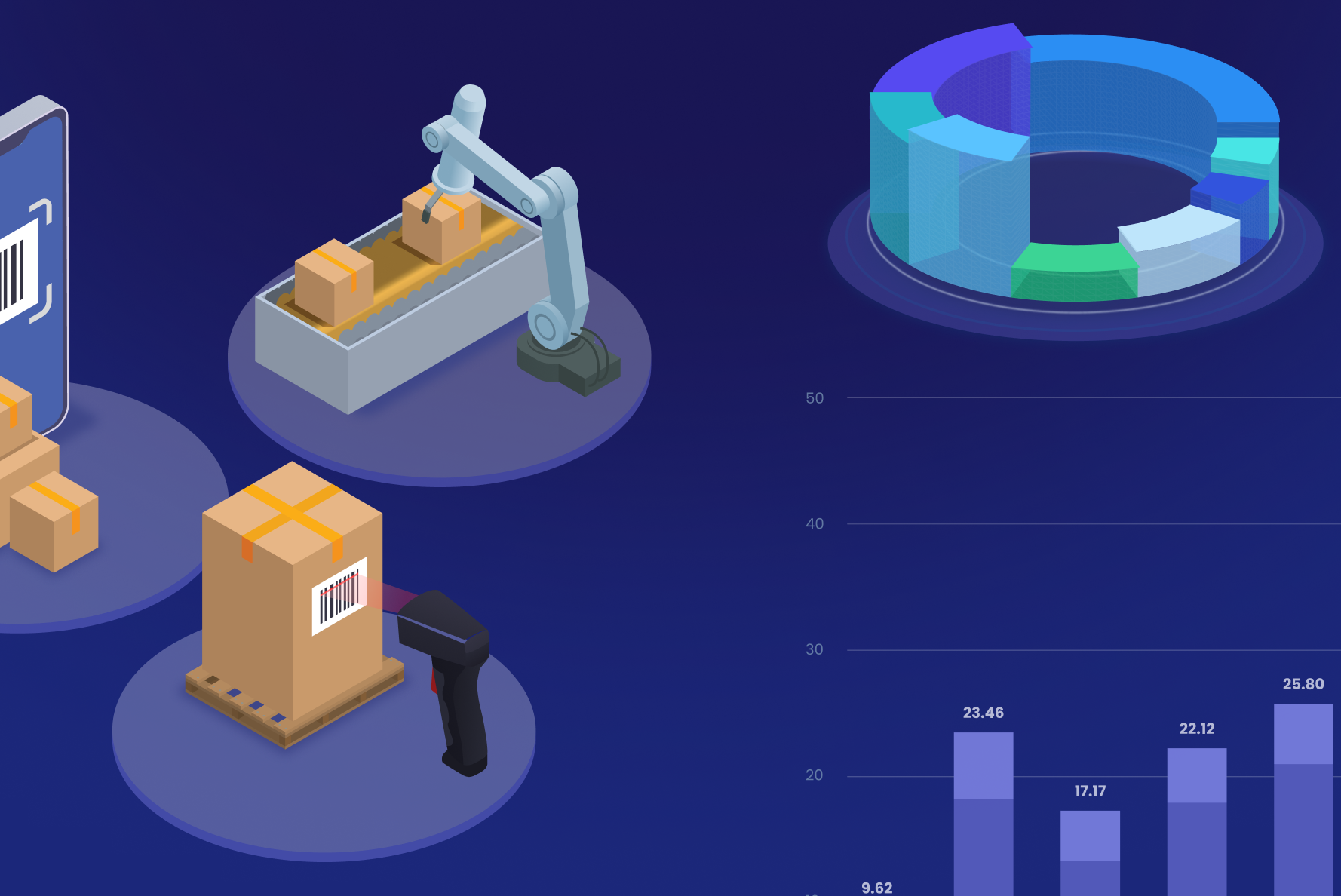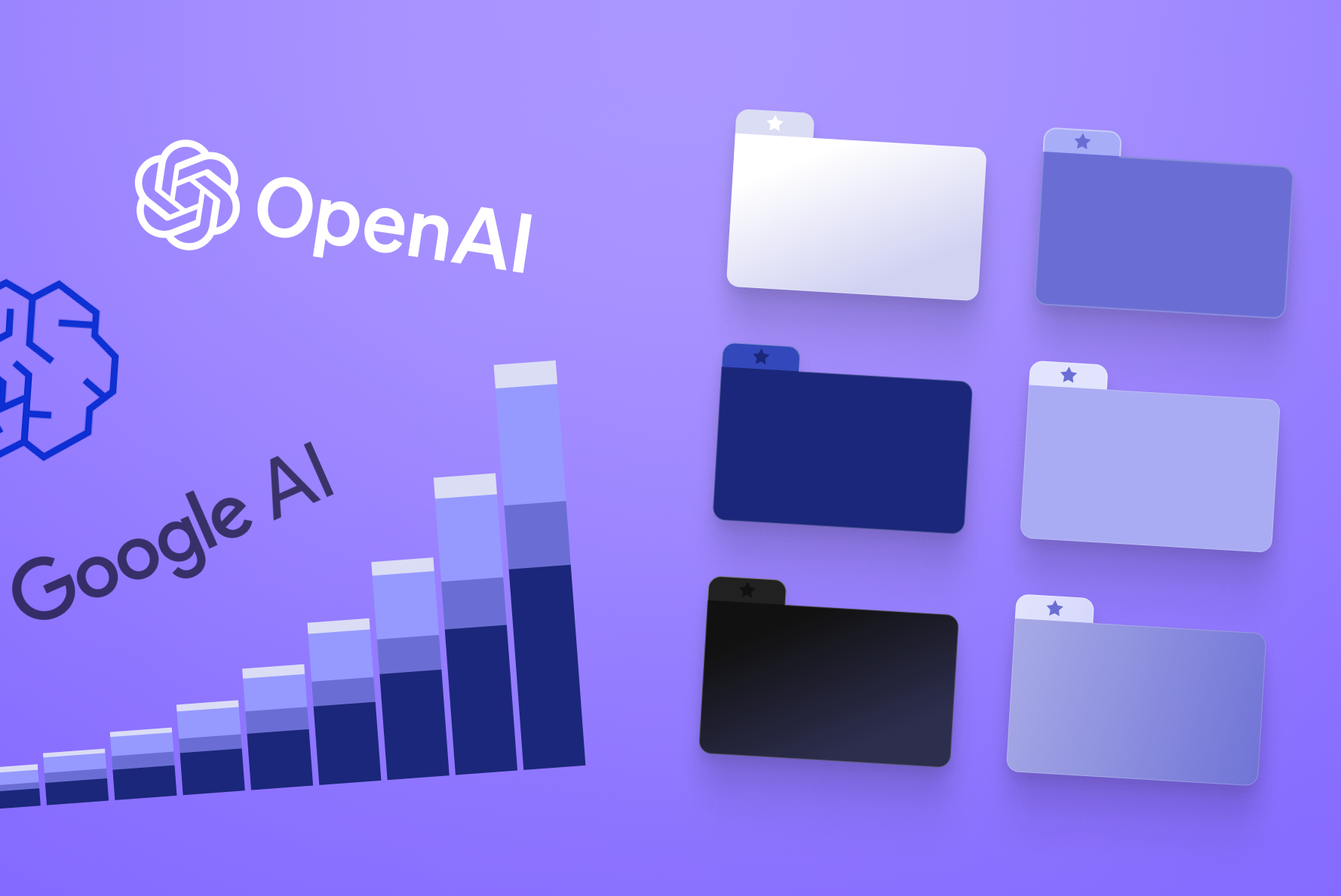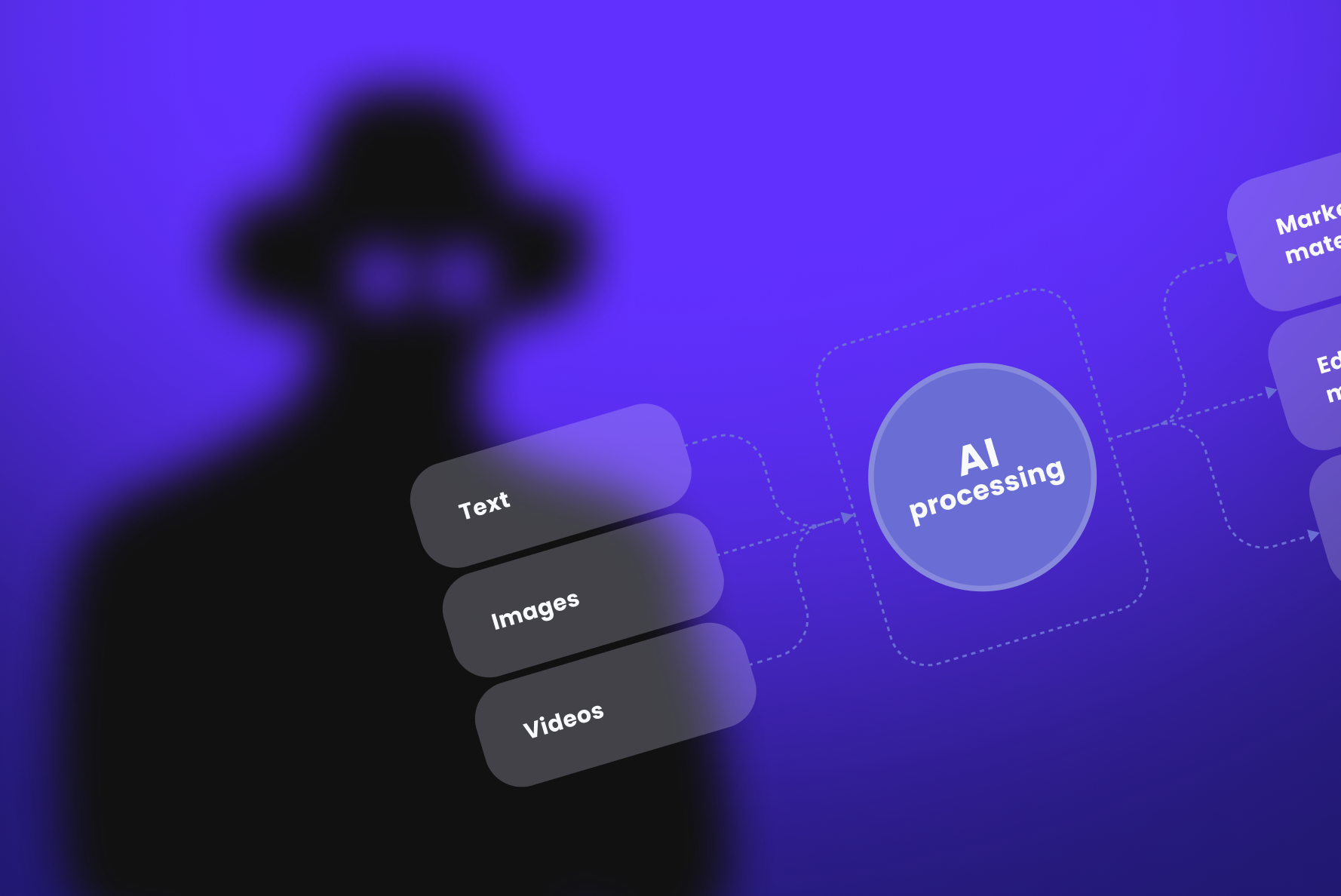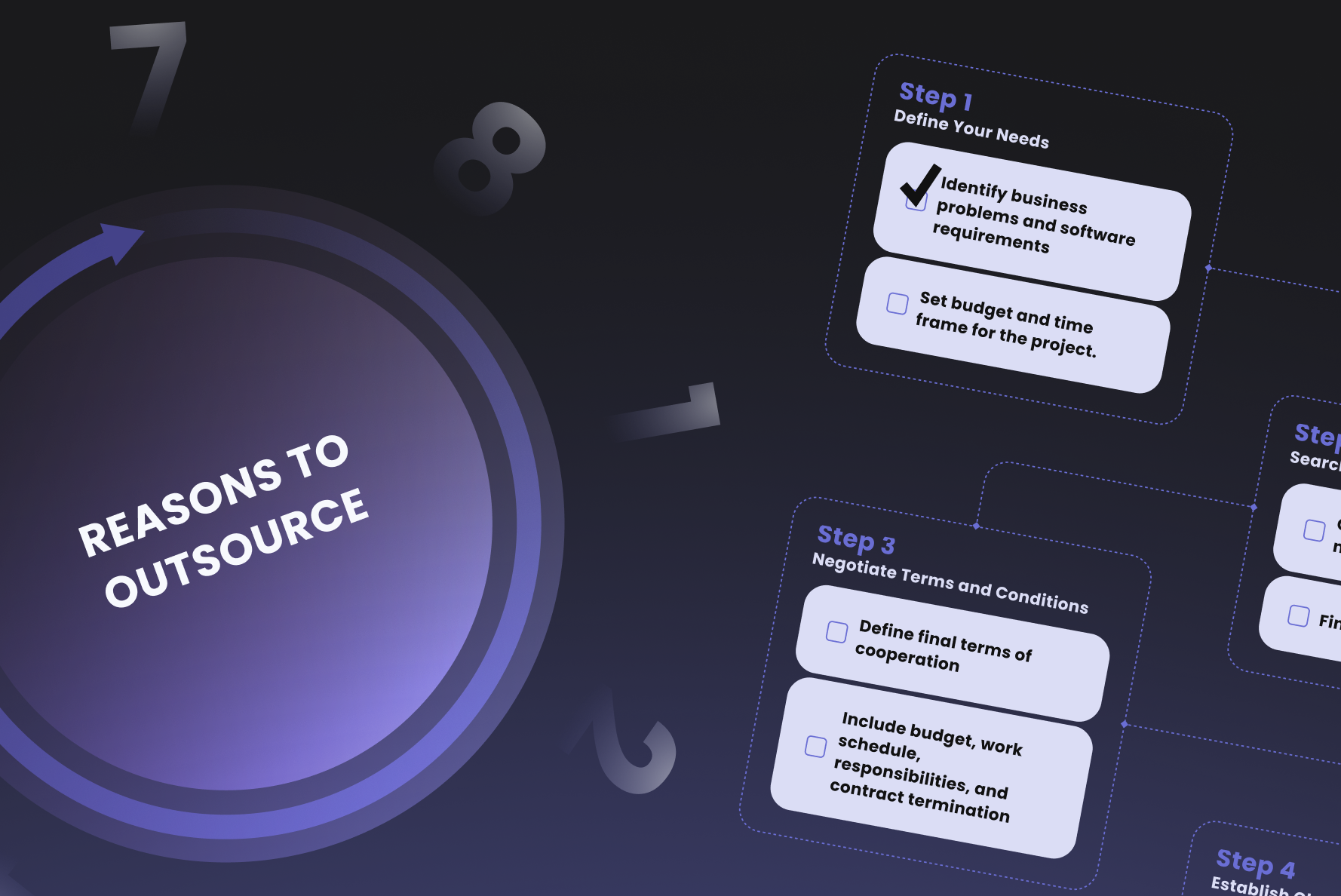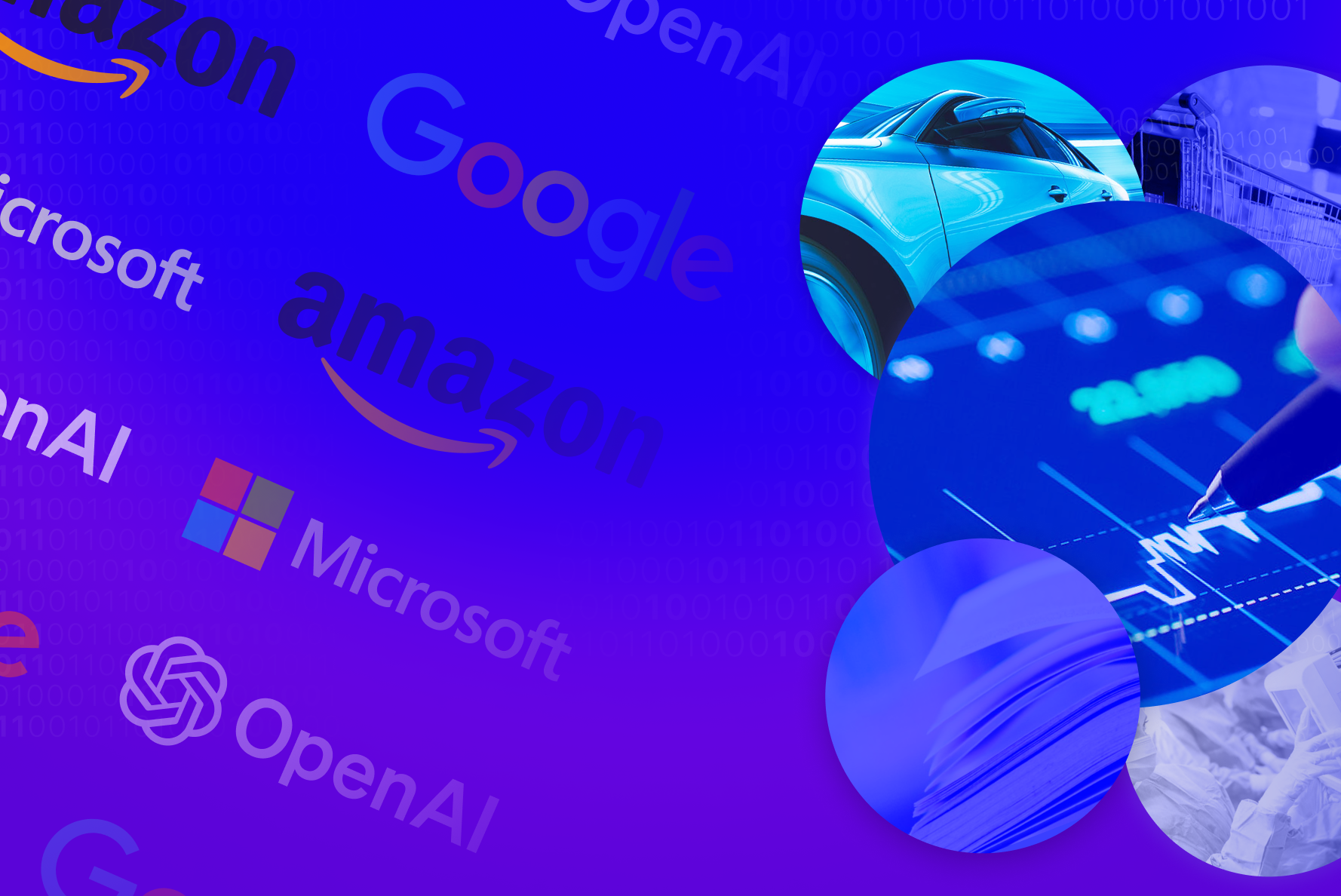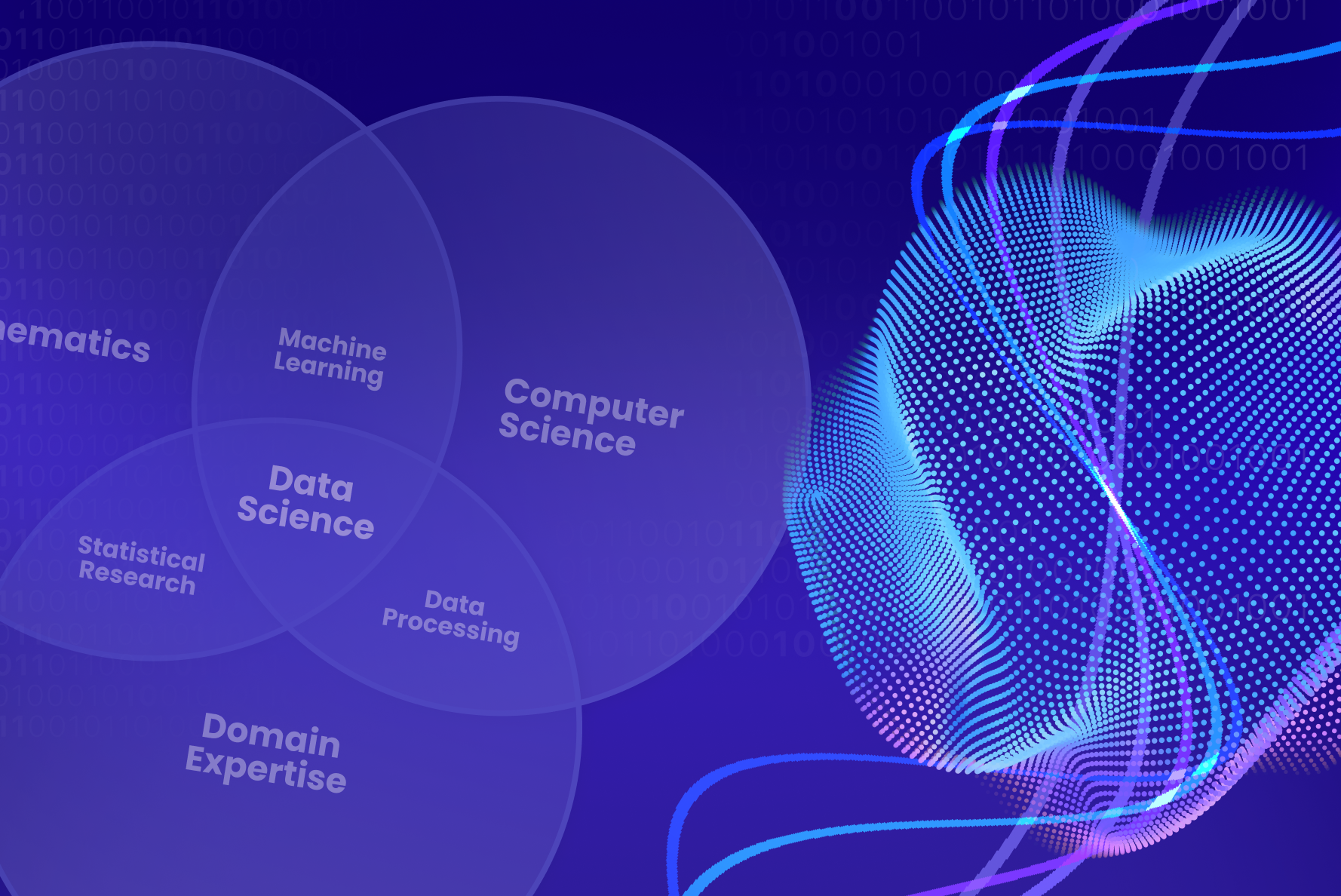Are you wondering about Golang vs Python for the backend? While Python still holds the leading position as the world’s most used programming language, Go coding is only on its way to crawling up the ladder. The 2022 study by Statista shows that every second developer is expertise in Python, while only 1 out of 10 specialists use Go in programming.
That is no wonder: being released in 2009, Golang is known as one of the youngest programming languages today, with over 1,1 million professional devs using it as a primary language. On the contrary, Python has a strong community with over 8.2 to 10 million developers working with it alone, according to multiple estimates. So, does that mean that in the battle Golang vs Python the last one wins?
In this article, Uvik’s best development experts explain the major differences between these two programming languages and highlight the key use aspects of each. By the end of this overview, you’ll be able to answer whether or not you need to hire Python developers or Golang professionals.
Finally, if you still have any questions concerning the topic, or need some assistance in hiring expertised Python or Golang developers for your project – Uvik’s experts are always ready to help!
Go vs. Python: Quick Comparison Table
To get a better idea of the difference between Python and Golang, let’s start the comparison with a brief overview of their technical characteristics:
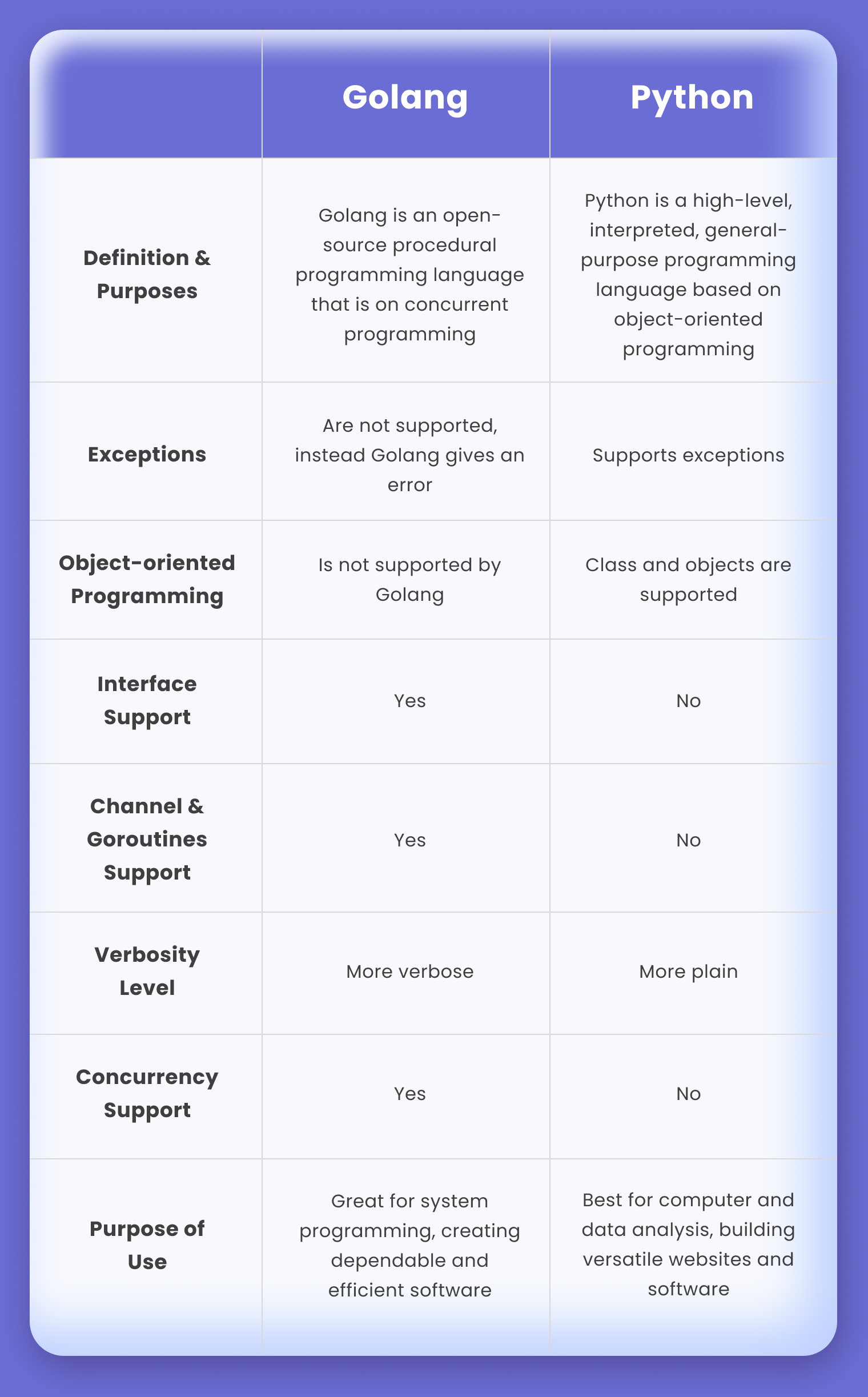
What Are Go and Python Used for?
Before you start comparing what is better than Python or Golang, you should understand in which cases it is worth using one or another development language.
Python Use Cases
Released in 1991, Python’s core philosophy is centered around the code readability concept. Therefore, this language is best for:
- Learning the programming basics
- Implementing the ideas into simple code lines
- Effortlessly reading and sharing code with others
Thus, there are a variety of different areas where Python is applied today, including AI and machine learning, data analytics, data visualization, app programming and web development, language development, and more.
Go Use Cases
Go programming language was released in 2009 and is basically focused on creating dependable and efficient software. Because of its flexibility and ability to solve different problems, Golang is used for system and network programming, big data, machine learning, audio, and video editing, and more. This language is best for:
- Creating scalable servers and large software systems
- Writing concurrent programs
- Launching speedy and lightweight microservices
Above are only a few examples where Golang is more productive compared to other alternatives such as Python. Below we’ll discuss in detail the key aspects highlighting when to use Golang over Python and what opportunities each of the options has.
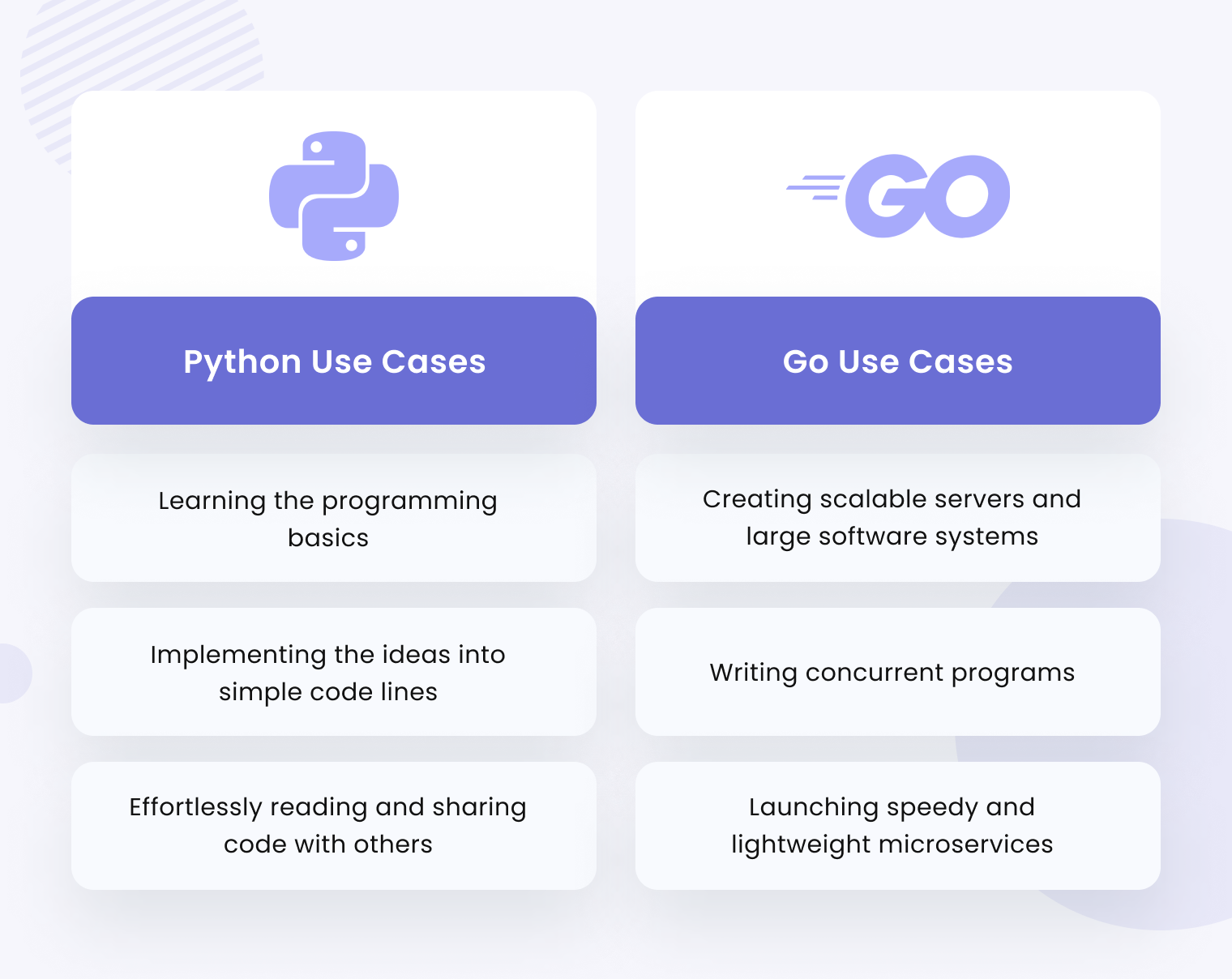
Golang vs. Python: Pros and Cons
While both languages are applicable for web development, their popularity within the target industry still greatly depends on the efficiency and convenience each option features.
Uvik has extensive experience outstaffing top companies with Golang and Python engineers, so we are well aware of the main pros and cons of both technologies.
Thus, based on UVIK team’s experience and understanding of the main use cases, let’s analyze the perks and weak sides of applying to Go language vs Python for web development, so that you could clearly understand the potential of both.
Why Use Python for Web Development?
Python’s wide range of libraries and frameworks make it a perfect choice for web development and prototyping. It accelerates the development speed and allows getting all the functionality implemented straight out of the box.
Moreover, if your project is based on data science, ML, or AI-based solutions, Python’s technical performance will be the right choice due to its flexibility, simplicity, and consistency. In other words, when choosing between Go or Python for machine learning, artificial intelligence, or any other Big data projects – definitely choose the second one.
Finally, Python features an extremely wide community, which can become a great advantage in the process of web development.
Why Use Golang for Web Development?
Choosing the Go language for the web development project can be also a good option, especially if the speed of execution or concurrency are your main priorities. Though Golang has comparatively fewer libraries and a smaller community, developers still consider it an excellent choice for large, production-grade applications.
Why? The answer is pretty simple: it has excellent standard library support for implementing networking and Internet protocols, which is essential for web development and web app programming.
Python vs. Go: Deep Comparison
So far we’ve discussed the basic differences between Golang and Python, as well as their performance in web development. Now, let’s go deeper by comparing these languages in terms of different factors, including their speed, scalability, execution, libraries, and other aspects that matter in the process of project development and its successful delivery.
Popularity
With nearly two decades of difference in industry presence, Python has been widely known as a versatile programming language that can be used for almost anything. So, there’s no wonder that it is among the five most used programming languages around the world, with over 48% of developers using it on a daily basis.
On the contrary, Golang is less popular among developers today, with 1,6 – 2,5 million professionals using it as a primary language in 2021. In 2022, the Go language popularity became even less and decreased, by about 2-3%.
There is also a significant difference in the geographical distribution of Python and Go. The first language is mainly popular in North America, India, and Western European countries, while Golang has the highest support from Asian software engineers and IT specialists from Oceania, with over 700,000 developers using it as the main language.
Performance
One of the easiest ways to check the Python vs Go performance is to try solving complex mathematical functions. This approach allows checking the memory management and time spent in solving the problem.
Speaking of the performance of Golang and Python, things are as follows. Golang was designed with a focus on productivity and the relative simplicity of Python, and the complex mathematical test proves that accordingly. In its workflow, the Go language uses “goroutines” or lightweight processes, working with the collections of packages for efficient dependency management.
This feature explains why most developers prefer Golang over Python – it allows users to create dependable and efficient software.
Frameworks
The framework can be an extremely helpful tool in the development process, which allows for building the apps and web solutions in a shorter time. In this aspect, the Go and Python languages are diametrically different: while Python comes with a wide selection of open-source and cross-platform frameworks, the Go doesn’t have a single ingrained framework for software development.
The importance of frameworks, however, depends on the type of project and its technical requirements. According to this logic, the final decision on which language is a better fit is based on the development strategy and the client’s preferences.
Scalability
Regardless of the application, its type, or the target industry, it’s more than likely to scale with time. Therefore, scalability has already become an essential aspect of nearly any software developed today.
Though Python has been commonly used for both startups and large-scale projects, compared to Golang it still has scalability limitations due to its parallel process channeling, i.e. parallelism.
This means the application splits the tasks into smaller subtasks that are processed in parallel (usually, it requires significant CPU resources and does not always fit large-scale projects).
Golang, however, has the inbuilt support for concurrent process channeling, according to which the application can work with more than one task at a time (the next task can be started before the previous is completed), which significantly optimizes the efficiency of large-scale projects.
Therefore, in the terms of scalability of Golang vs Python, the Go language is definitely a winner.
Application
Each language has been designed based on a specific technology, such as web development, AI or ML solutions, cloud computing, big data, and more. Talking about Go vs Python, there’s a similar differentiation in the use fields as well.
Python language is widely applied in the following areas:
- Data analytics
- Artificial intelligence and machine learning
- Deep learning
- Web development
This is mostly credited to the variety of libraries available for Python, making the development chores in the said fields a whole lot easier.
On the contrary, Golang is mainly targeted at systems programming due to its technical features. Apart from that, you can find the applications of Go in the following areas:
- Cloud computing and cluster computing
- Web development
- Server-side applications
- DevOps
The popularity of the language within the target fields is explained by the Go’s major features: concurrency support, powerful and easy-to-use libraries, and, of course, its speed (Golang features a way faster performance compared to Python).
Execution
One more difference when comparing Golang vs Python is their code execution. As you’ve already discovered from the table above, Golang is a statically typed language, while Python language is statically typed. But what does that mean in terms of software development?
A statically typed language is one where variable types are directly declared for the compiler, which benefits easier debugging and error-shooting. With the dynamically typed language, type inference is implemented by the developer, there are higher risks of missing the bugs or components misinterpretation.
In other words, the code limitations in Python might reduce the errors in the process which is critical for big programs. Though Golang has fewer limitations, it still can be tricky to debug, which is why it’s mainly used by developers experienced in coding.
Libraries
Since Golang is comparatively new in the development industry, it offers fewer library packages compared to Python, which has been in the play for decades. Go’s fundamental library packages enable fast, robust, and efficient development of different projects, including web platforms, lightweight applications, cloud computing solutions, and more.
However, if you’re working with really big data or need a wider range of libraries to choose from for the project, then opt for Python language instead. So far, Python has a large selection of nearly 140,000 libraries that can facilitate code writing across many fields, including machine learning, data science, data visualization, image and data manipulation, and many more. So when comparing libraries Python 3.11 vs Golang, Python is the clear winner here.
Readability
When working with other developers or multiple teams, code readability becomes an essential factor that can either make or break the development process.
Python features excellent readability, but sometimes developers can go too deep with this feature. The thing is that there are dozens of ways to say the same thing in Python-based code, which might result in misinterpretation.
Go language features a high verbality level, but has more strict programming rules, therefore a definite way of performing certain tasks. This means the code is less likely to be misinterpreted.
It’s also worth mentioning that Golang is mainly used by expertised developers, while Python enters the top 5 of the world’s most popular programming languages, and therefore has a great advantage compared to Go.
Prototyping
Talking about software prototyping, Python is an ideal option due to its dynamic nature. The language’s simplicity and ease of use enable it to quickly create an MVP even with limited resources or knowledge in advanced program development.
Golang is static and requires deeper programming expertise, which makes the prototyping more challenging, even if it’s just a lightweight authentication microservice.
Machine Learning
The ML platform development can be performed using both languages. Nevertheless, as mentioned above in the Golang vs Python web development overview, Python language is believed to be a better option for this field.
Basically, that’s because of a large selection of machine learning algorithms, plugins, model predictions, and other useful packages outlined in Python’s libraries.
Compared to Python, the Go language still lacks many helpful resources in this field. Additionally, Golang is less preferable for ML development due to its more complicated debugging and higher verbality.
Deep Learning
Similar to the logic of machine learning development, Golang is less likely to be applied in deep learning. Of course, there are some options such as GoLearn, Goml, and Hector frameworks, but it’s not always enough to tackle the project’s specifics.
The lack of Go-based frameworks and limited selection of libraries makes the process more challenging and tricky, especially when compared to opportunities coming with Python.
Data Science
Over the years, Python has always been the top choice for data science and analytics. With more and more Python libraries and frameworks supporting math, AI, distributed processions, statistics, and other related areas, this language is perfect for launching any data-based project.
Golang has only started evolving in AI-related technology, but in terms of data science, it still lacks maturity and community support.
Key Differences Between Go and Python
Above we discussed the basic use cases and web development specifics of each language, as well as reviewed a comprehensive Golang Python comparison. Now, let’s summarize the key aspects of Go vs Python to gain the final idea of the difference between Go and Python.
- Python is a scripting language that requires interpretation while working with Golang can significantly optimize the workflow as it doesn’t count on anything at runtime.
- Unlike Python, Go is packed with a built-in concurrency mechanism that perfectly fits scalable projects.
- In terms of syntax of Golang vs Python, the last one is easier to understand (user-friendliness), which benefits readability and flexibility.
- As opposed to the Golang language which still lacks a large selection of libraries, Python comes with dozens of options within this area.
- Compared to Python in terms of the same functionality, the Go language is more verbose and less compact.
- Golang is a statically typed language while Python refers to the dynamic-focused language category. In this case, the major benefit of Go is that it helps to effectively detect flaws and reduce serious glitches later in the production.
Finally, Python language is the best choice for the basic programming routines, which is mainly used for standard systems. However, when it comes to creating complex, large-scale projects, Go can be executed faster and more effectively.
Go vs Python: Which is Better in The End
Having covered all the essential aspects of both programming languages, it’s time to decide which is better: Python vs Golang in 2022. Depending on the project specifics, technical requirements, and functionality, both options can be the winning ones in this battle.
Basically, both Python and Golang have their own share of benefits. They have clear syntax and can greatly optimize the development process if applied based on the advantages they provide for developers.
Go language will be the best in terms of high productivity, speed, and large scalability, it’s much simpler to debug and read for the programmers. It comes close to the speed of C/C++, is extremely easy to use, and enables reducing the manual memory management processes. Due to this, Golang will be the best fit for various system programming projects.
Python, however, features high versatility due to the number of libraries and the range of syntax, which is an excellent choice for cross-team readability and use. It is less verbal and supports clean coding, which is important for machine learning projects and other data science problems.
Uvik Will Help You Decide Between Python and Golang
At Uvik, we have years of experience working with both Golang and Python languages across different projects. Our team features a deep theoretical and practical knowledge of both options and can help you to find the best Python developers, as well as reliable Golang experts for any project you want to create.
Along with the strong focus on client preferences, we’re also concerned about delivering the most effective and beneficial outcome. Our managers are always ready to deliver a personalized solution that ideally meets your business.
With Uvik, you can access hundreds of dedicated programmers for building robust and functional software for various industries including eCommerce, media platforms, finance, enterprise, and more. Should you need any help with Golang Python comparison, request a free consultation from Uvik’s best experts to define the best solution for any project of yours!
Final Thoughts
Having discovered the key differences between Golang vs Python, it becomes more than clear which one will work best for your project. You’ll choose Python when you need to solve complex data science problems, numeric computing, various web development, and OS automation processes that require parallel execution. On the contrary, with Golang you can quickly program simple systems which are responsive and effective thanks to Go’s support for concurrency.
However, it’s totally okay if you haven’t decided which of the languages can fit best to your project. Contact Uvik today to get a comprehensive consultation on using Python vs Golang for a personal project!
Still have some questions about Golang and Python programming languages? Get some more insights about the use cases, development costs, and other related aspects from the questions below!






